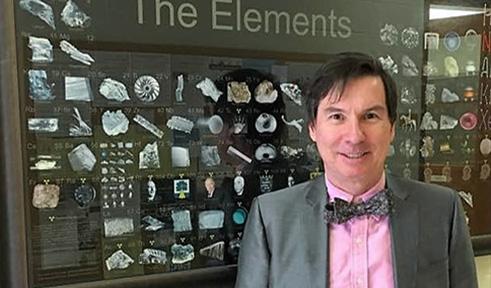Peter de B. Harrington

Recent News
Education
Ph.D., University of North Carolina
Research
- Chemometrics Forensic Chemistry
- Bioinformatics
- Ion Mobility Spectrometry
- Mass Spectrometry
- Proteomics
- Bacteria
- Personal Page
The nature and significance of my scholarship is directed toward the development of intelligent chemical instruments. I am working with ion mobility spectrometry (IMS) and mass spectrometry (MS). These two methods are complementary and are distinguished by the pressure at which the ion measurement is made. If the ion velocities are measured in the gas phase at atmospheric pressure, the ion mobility is determined by an ion's volume-to-charge ratio. If the ions are measured under vacuum conditions (i.e., less than a millionth of atmospheric pressure) then their velocity is determined by the mass-to-charge ratio of the ion. Because ion mobility spectrometers do not require a vacuum system, they are more portable, less costly, more rugged, and amenable to miniaturization. Mass spectrometers have the advantages of greater resolving and informing power when compared to ion mobility spectrometers.
My group is interested in coupling chemometric methods with ion mobility and mass spectrometers, so that the chemometric methods are transparent to the user and so that the instrument exhibits intelligent behavior. An intelligent instrument furnishes user- or problem-defined information as opposed to data that must be interpreted by a scientist. My group is developing algorithms that perform real-time signal processing, modeling, and interpretation.
There are several application areas that interest us. We are developing methods for rapid identification of bacteria or biogenic compounds using IMS and MS. Our forensic projects involve improving the identification of drugs of abuse and explosives by IMS, as well as adapting IMS to new applications such as accelerant detection for arson cases. My group is studying and characterizing bacteria digests and whole-cell bacteria by matrix assisted laser desorption/ionization (MALDI)-MS. The mass spectral data is used to profile the bacterial proteins. My group has been actively involved in biomarker detection in MS data since 1990. Presently, we are investigating early diagnosis of disease from MS data as well as using MALDI-MS as a rapid forensic analysis tool.
Recent Journal Publications
(1/1/2018 to 4/1/2020)
Publications for the last two years. A complete bibliography can be found in his CV on his Personal Page.
(*Denotes corresponding author)
- Z. Chen, M. NaderiNasrabadi, J.A. Staser, and P.B. Harrington*, Generalized Standard Addition Method to Characterize an Electrolytic Lignin Reactor using Ultraviolet Spectroscopy. Journal of Analysis and Testing (2020) DOI: 10.1007/s41664-020-00119-y.
- Z. Yuan, L. Zhang*, D. Wan, J. Mao, J. Jiang, Q. Zhang, P.B. Harrington, P. Li, Detection of flaxseed oil multiple adulteration by near-infrared spectroscopy and nonlinear one class partial least squares discriminant analysis. LWT-Food Science and Technology (2020) DOI: 10.1016/j.lwt.2020.109247.
- P.B. Harrington*, Enhanced Zippy Restricted Boltzmann Machine for Feature Extraction and Classification Enhancement of Analytical Data. Journal of Chemometrics (2020) DOI: 10.1002/cem.3228.
- L. Wang, R. Yang*, L. Qu, P.B. Harrington, Electrostatic repulsion strategy for high-sensitive and selective determination of dopamine in the presence of uric acid and ascorbic acid. Talanta (2019) DOI: 10.1016/j.talanta.2019.120626.
- Y. Wang, P.B. Harrington, P. Chen*, Analysis of phenolic compositions in cranberry dietary supplements using UHPLC-HRMS. Journal of Food Composition and Analysis (2019) 86 DOI: 10.1016/j.jfca.2019.103362.
- Z. Chen and P.B. Harrington*, Pipeline for High-Throughput Modeling of Marijuana and Hemp Extracts. Analytical Chemistry (2019) 91(22) 14489-14497 DOI: 10.1021/acs.analchem.9b03290.
- J.D. McChesney*, J. Dou, P.B. Harrington, The Development of Botanical Drugs – A Review. Pharmaceutical Regulatory Affairs (2019) 8(2) 1-9 ISSN: 2167-7689.
- Z. Chen and P.B. Harrington*, Automatic Soft Independent Modeling for Class Analogies. Analytica Chimica Acta (2019) DOI: 10.1016/j.aca.2019.09.035.
- M. NaderiNasrabadi, F. Bateni, Z. Chen, P.B. Harrington, and J.A. Staser*, Biomass-depolarized Electrolysis. Journal of the Electrochemical Society (2019) 166(10) E317-E322 DOI: 10.1149/2.1471910jes.
- L. Wang, R. Yang, Ji. Li, L. Qu*, and P.B. Harrington, A highly selective and sensitive electrochemical sensor for tryptophan based on the excellent surface adsorption and electrochemical properties of PSS functionalized graphene. Talanta (2018) 196 309-316 DOI: 10.1016/j.talanta.2018.12.058.
- Y. Tang and P.B. Harrington*, Non-Integer Root Transformations for Preprocessing Nano-Electrospray Ionization High-Resolution Mass Spectra for the Classification of Cannabis. Analytical Chemistry (2018) 91(2) 1328-1334 DOI: 10.1021/acs.analchem.8b03145.
- Z. Chen, P.B. Harrington*, and S.F. Baugh, High-throughput Authentication of Cannabis and Hemp Extracts Using an Ultraviolet Microplate Reader and Multivariate Classifiers. Journal of Analysis and Testing (2018) 2(3) 210-222 DOI: 10.1007/s41664-018-0075-3.
- Y. Wang, N. Vorsa, P.B. Harrington, and P. Chen*, Non-Targeted Metabolomic Study on Variation of Phenolics in Different Cranberry Cultivars Using UPLC-IM-HRMS. Journal of Agricultural and Food Chemistry (2018) 66(46) 12206–12216 DOI: 10.1021/acs.jafc.8b05029.
- M. Jie, S. Yu, F. Yu, L. Liu, L. He, Y. Li, H. Zhang, L. Qu*, P.B. Harrington, and Y. Wu, A ultrasensitive chemiluminescence immunoassay for fumonisin B1 detection in cereals based on gold-coated magnetic nanoparticles. Journal of the Science of Food and Agriculture. (2018) 98 3384-3390 DOI: 10.1002/jsfa.8849.
- X. Wang and P.B. Harrington*, Differentiating Rice Varieties by Inductively Coupled Plasma Mass Spectrometry Chemical Profiling with Singular Value Decomposition Background Correction, Journal of Analysis and Testing. (2018) 2 138-148 DOI: 10.1007/s41664-018-0055-7.
- P.B. Harrington*, Feature Expansion by a Continuous Restricted Boltzmann Machine for Near-Infrared Spectrometric Calibration, Analytica Chimica Acta. (2018) 1010 20-28 DOI: 10.1016/j.aca.2018.01.026.
- X. Wang, P.B. Harrington*, and S.F. Baugh, Effect of Preprocessing High-Resolution Mass Spectra on the Pattern Recognition of Cannabis, Hemp, and Liquor, Talanta (2018) 180 229-238 DOI: 10.1016/j.talanta.2017.12.032.
- P. Liu, X. Zhang, B. Pan, Mi. Wei, Z. Zhang*, P.B. Harrington, Classification of Sand Grains by Terahertz Time-Domain Spectroscopy and Chemometrics. International Journal of Environmental Research (2018) 13(1) 143-160 DOI: 10.1007/s41742-018-0159-y.
- P.B. Harrington, Multiple Versus Single Set Validation to Avoid Mistakes, CRC Critical Reviews in Analytical Chemistry. (2018) 48(1) 33-46 DOI: 10.1080/10408347.2017.1361314.
- A.K. Aloglu and P.B. Harrington*, Differentiation of Bovine, Porcine, and Fish Gelatins by Attenuated Total Reflectance Fourier Transform Infrared Spectroscopy (ATR-FTIRS) Coupled with Pattern Recognition. Journal of Food Composition and Analysis. (2018) 101(1) 221-226 DOI: 10.5740/jaoacint.17-0244.